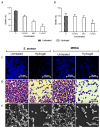Protium spruceanum Extract Enhances Mupirocin Activity When Combined with Nanoemulsion-Based Hydrogel: A Multi-Target Strategy for Treating Skin and Soft Tissue Infections
- PMID: 38931824
- PMCID: PMC11207036
- DOI: 10.3390/pharmaceutics16060700
Protium spruceanum Extract Enhances Mupirocin Activity When Combined with Nanoemulsion-Based Hydrogel: A Multi-Target Strategy for Treating Skin and Soft Tissue Infections
Abstract
The treatment of skin and soft tissue infections (SSTIs) can be challenging due to bacterial resistance, particularly from strains like MRSA and biofilm formation. However, combining conventional antibiotics with natural products shows promise in treating SSTIs. The objective of this study is to develop a nanoemulsion-based hydrogel containing Protium spruceanum extract and mupirocin and evaluate its potential for the treatment of SSTIs. The nanoemulsion was obtained by phase inversion and subsequently characterized. The antibacterial activity was evaluated in vitro against S. aureus MRSA, including the synergism of the combination, changes in membrane permeability using flow cytometry, and the anti-biofilm effect. In addition, the irritative potential was evaluated by the HET-CAM assay. The combination exhibited synergistic antibacterial activity against S. aureus and MRSA due to the extract enhancing membrane permeability. The hydrogel demonstrated suitable physicochemical properties, inhibited biofilm formation, and exhibited low irritation. The formulation was nanometric (176.0 ± 1.656 nm) and monodisperse (polydispersity index 0.286 ± 0.011). It exhibited a controlled release profile at 48 h and high encapsulation efficacy (94.29 ± 4.54% for quercitrin and 94.20 ± 5.44% for mupirocin). Therefore, these findings suggest that the hydrogel developed could be a safe and effective option for treating SSTIs.
Keywords: Protium spruceanum; SSTIs; antibacterial; nanoemulsion-based hydrogel; synergistic activity.
Conflict of interest statement
The authors declare no conflicts of interest.
Figures








Similar articles
-
New Synergistic Combination Therapy of Mupirocin and α-Pinene Against Multidrug-Resistant Clinical Strains of Methicillin-Resistant Staphylococcus aureus.P R Health Sci J. 2024 Jun;43(2):73-78. P R Health Sci J. 2024. PMID: 38860960
-
Role of Extracellular DNA in Dalbavancin Activity against Methicillin-Resistant Staphylococcus aureus (MRSA) Biofilms in Patients with Skin and Soft Tissue Infections.Microbiol Spectr. 2022 Apr 27;10(2):e0035122. doi: 10.1128/spectrum.00351-22. Epub 2022 Apr 13. Microbiol Spectr. 2022. PMID: 35416701 Free PMC article.
-
Antibiotic susceptibility and clonal distribution of Staphylococcus aureus from pediatric skin and soft tissue infections: 10-year trends in multicenter investigation in China.Front Cell Infect Microbiol. 2023 Jul 13;13:1179509. doi: 10.3389/fcimb.2023.1179509. eCollection 2023. Front Cell Infect Microbiol. 2023. PMID: 37520432 Free PMC article.
-
Topical Nanotherapeutics for Treating MRSA-Associated Skin and Soft Tissue Infection (SSTIs).AAPS PharmSciTech. 2023 Apr 26;24(5):108. doi: 10.1208/s12249-023-02563-2. AAPS PharmSciTech. 2023. PMID: 37100956 Review.
-
Treatment options for uncomplicated community-acquired skin and soft tissue infections caused by methicillin-resistant Staphylococcus aureus: oral antimicrobial agents.Surg Infect (Larchmt). 2008;9 Suppl 1:s29-34. doi: 10.1089/sur.2008.065.supp. Surg Infect (Larchmt). 2008. PMID: 18844472 Review.
Cited by
-
Chitosan Nanoparticles Enhance the Antiproliferative Effect of Lapachol in Urothelial Carcinoma Cell Lines.Pharmaceutics. 2025 Jul 2;17(7):868. doi: 10.3390/pharmaceutics17070868. Pharmaceutics. 2025. PMID: 40733077 Free PMC article.
References
-
- Walsh T.L., Chan L., Konopka C.I., Burkitt M.J., Moffa M.A., Bremmer D.N., Murillo M.A., Watson C., Chan-Tompkins N.H. Appropriateness of antibiotic management of uncomplicated skin and soft tissue infections in hospitalized adult patients. BMC Infect. Dis. 2016;16:721. doi: 10.1186/s12879-016-2067-0. - DOI - PMC - PubMed
-
- Guo Y., Ramos R.I., Cho J.S., Donegan N.P., Cheung A.L., Miller L.S. In vivo bioluminescence imaging to evaluate systemic and topical antibiotics against community-acquired methicillin-resistant Staphylococcus aureus-infected skin wounds in mice. AAC. 2013;57:855–863. doi: 10.1128/AAC.01003-12. - DOI - PMC - PubMed
-
- Penduka D., Mthembu W., Cele K.H., Mosa R.A., Zobolo A.M., Opoku A.R. Extracts of Ansellia africana and Platycarpha glomerata exhibit antibacterial activities against some respiratory tract, skin and soft tissue infections implicated bacteria. S. Afr. J. Bot. 2018;116:116–122. doi: 10.1016/j.sajb.2018.02.403. - DOI
LinkOut - more resources
Full Text Sources

